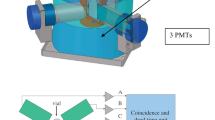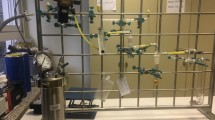Abstract
A set of solvents and commercially available scintillation cocktails were tested to provide inexpensive solvents, which can be applied directly for 222Rn elution from the charcoal vials used for indoor radon determination by means of Pico-Rad detectors. The addition of ethanol provides faster and more accurate transfer of the Rn from the charcoal. This study investigates the ability of solvents added directly to charcoal to efficiently displace radon from the charcoal into the gas and/or solvent phases which may be in close proximity to the charcoal.


Similar content being viewed by others
References
PAA Annual Report, Activities of the President of National Atomic Energy Agency (PAA) and assessment of nuclear safety and radiological protection in Poland in 2013, Warszaw 2014
Przylibski TA (1996) Zmienność koncentracji radonu w powietrzu Jaskini Niedźwiedziej w Kletnie (Sudety). Prz Geol 44(9):942–944
ICRP (2013) Directive 2013/59/Euratom of 5 December 2013, Basic safety standards for protection against the dangers arising from exposure to ionising radiation. Off J Eur Union L13:1–73
Olszewski J (2010) Assessment of radiation exposure of miners to radon and its daughter products in selected non-ferrous metal mines. Med Pr 61(6):635–639
Washington JW (1996) Gas partitioning of dissolved volatile organic compounds in the vadose zone: principles, temperature effects and literature review. Groundwater 34(4):709–718
Bem H, Olszewski M, Kaczmarek A (2004) Concentration of selected natural radionuclides in the thermal groundwater of Uniejów Poland. Nukleonika 49(1):1–5
Grabowski P, Długosz M, Szajerski P, Bem H (2010) A comparison of selected natural radionuclide concentrations in the thermal groundwater of Mszczonów and Cieplice with deep wellwater from Łodz city Poland. Nukleonika 55(2):181–186
Prichard MH, Marien K (1983) Desorption of radon from activated carbon into a liquid scintillator. Anal Chem 55(1):155–157
Schroeder M, Vanags C, Hess U (1989) An activated charcoal-based liquid scintillation-analyzed airborne Rn detector. Health Phys 57(1):9–148
Gudjónsson GI, Theodórsson P, Sigurdsson K, Kozak K, Grzadziel D (2008) a study of the simple open-vial liquid scintillation method for measurement of radon in air. Work presented on The international conference on advances in liquid scintillation spectrometry davos, Switzerland, 25–30 May 2008
Bem H, Bem EM, Chruścielewski W, Skalski H (2000) Temperature calibration of Pico-Rad detectors for radon measurement. Int J Occup Med Environ Health 13(2):147–154
Stawarz O, Karpińska M, Mamont-Cieśla K (2006) Investigation of the influence of high humidity and exposure duration on the measurement results of radon concentration by means of PicoRad system in the CLOR calibration chamber, Proceedings of the IV All-polish conference on radiochemistry and nuclear chemistry 9–11 May 2005, Kraków-Przegorzały, Poland, Nukleonika, 51(2):53–57
Chau ND (2008) Measurement of radon concentration in the air by PicoRad detectors. Nukleonika 53(Suppl 2):S21–S24
Bem H, Plota U, Staniszewska M, Bem EM, Mazurek D (2013) Radon concentrations in kindergartens and schools. J Radioanal Nucl Chem 295:2229–2232
Barbosa EQ, Galhardi JA, Bonotto DM (2014) The use of radon (Rn-222) and volatile organic compounds in monitoring soil gas to localize NAPL contamination at a gas station in Rio Claro, São Paulo State, Brazil. Radiat Meas 66:1–4
Cantaloub M, Higginbotham J, Semprini L (1997) The determination of Rn partition coefficients for several liquid scintillation cocktails. Proceedings, 43rd annual conference on bioassay, analytical and environmental radioactivity, Chareleston S.C., Nov 9–13 (1997)
Author information
Authors and Affiliations
Corresponding author
Additional information
Agnieszka Borkowska—Student in Technical University of Lodz
Rights and permissions
About this article
Cite this article
Długosz-Lisiecka, M., Borkowska, A. & Olszewski, J. 222Rn distribution coefficient in various organic scintillation cocktails. J Radioanal Nucl Chem 307, 869–874 (2016). https://doi.org/10.1007/s10967-015-4245-8
Received:
Published:
Issue Date:
DOI: https://doi.org/10.1007/s10967-015-4245-8




